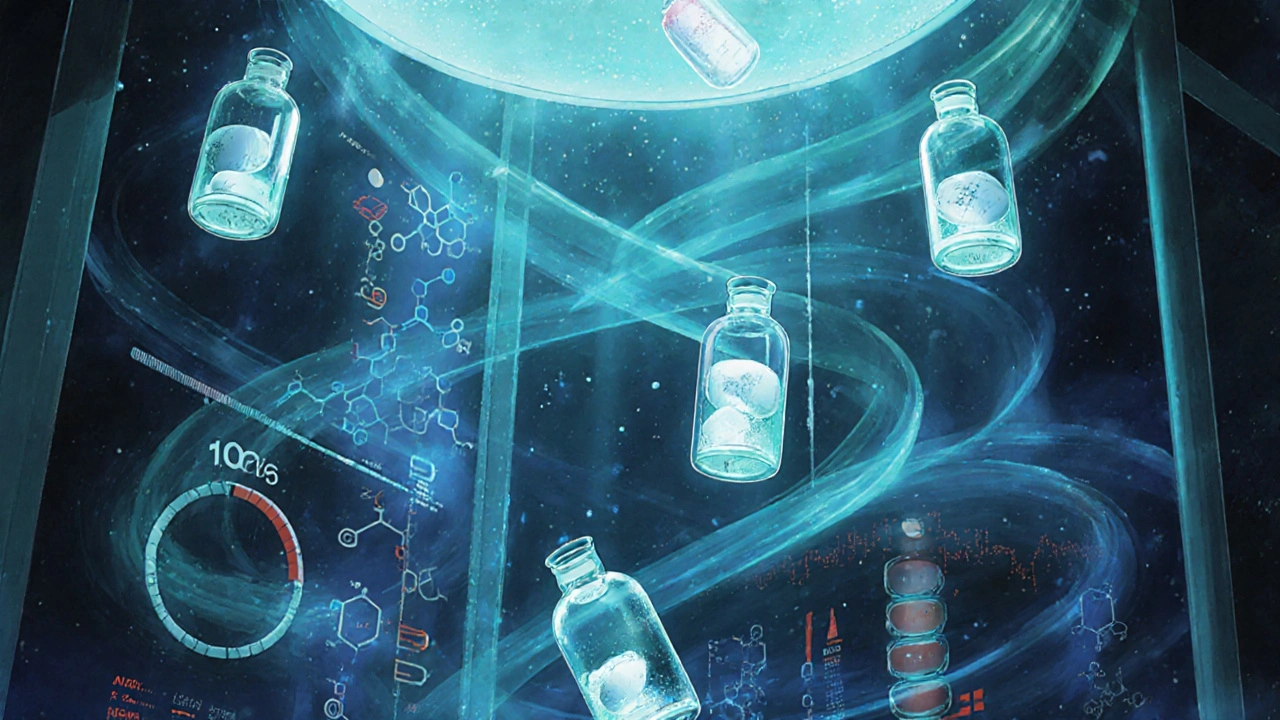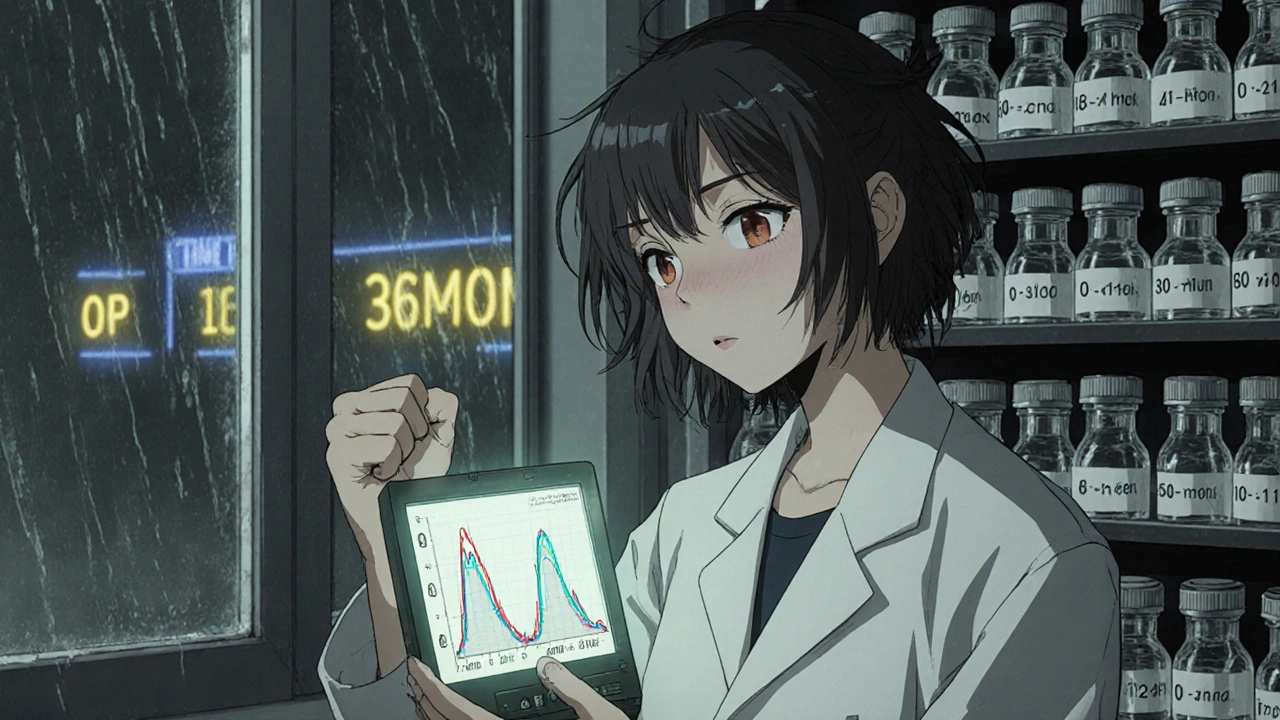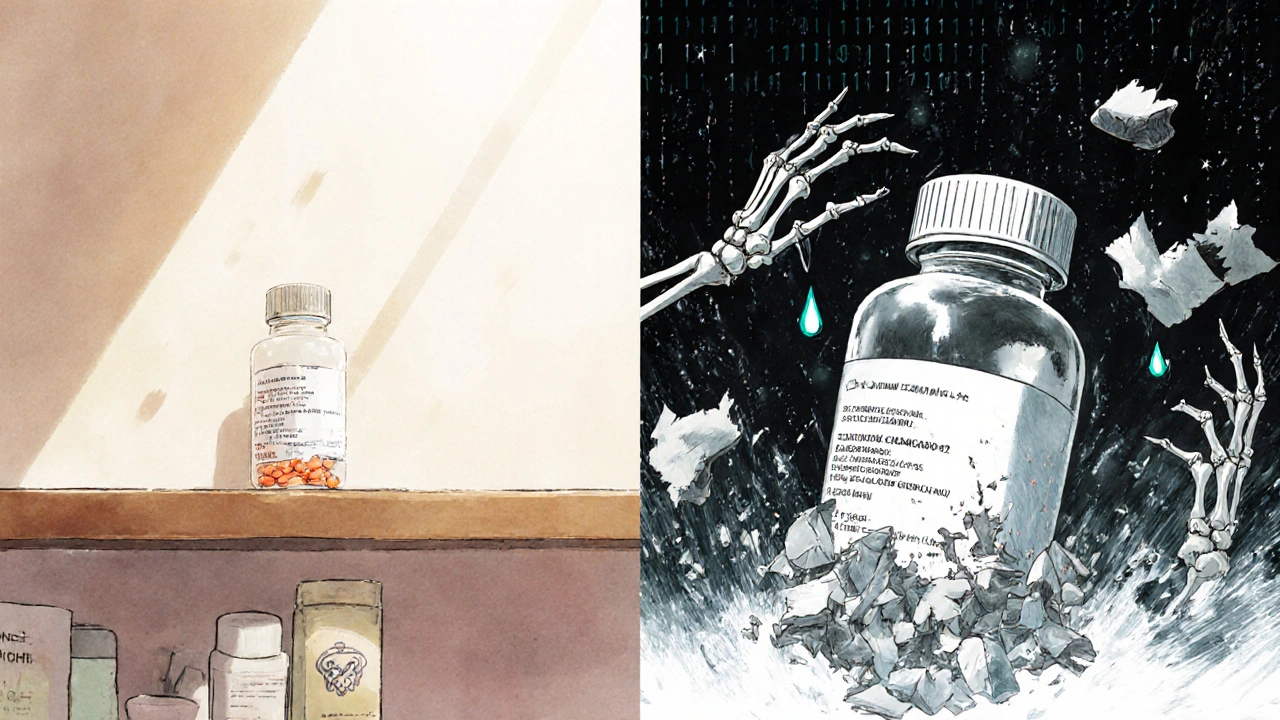Stability Testing: How Pharma Companies Monitor Drug Quality After Manufacturing
 Nov, 25 2025
Nov, 25 2025
When you pick up a bottle of medicine from the pharmacy, you assume it will work exactly as it should - even if it’s been sitting on the shelf for a year. But how do manufacturers know that? The answer isn’t guesswork. It’s stability testing, a rigorous, multi-year process that tracks how a drug changes over time under real-world conditions. This isn’t optional. It’s the backbone of drug safety and the reason your pills don’t turn into dangerous chemicals before you take them.
Why Stability Testing Exists
Pharmaceutical products aren’t static. Heat, moisture, light, and even the container they’re packed in can cause active ingredients to break down. A painkiller might lose potency. An antibiotic could form toxic byproducts. A biologic drug might clump together and stop working. Without stability testing, these changes would go unnoticed until someone gets sick - or worse. The system was formalized in the 1990s by the International Council for Harmonisation of Technical Requirements for Pharmaceuticals for Human Use (ICH). Before that, companies used inconsistent methods. Now, every new drug approved in the U.S., Europe, or Japan must submit stability data meeting ICH Q1A(R2) guidelines. The goal? Prove the drug stays safe, effective, and within strict chemical limits until its expiration date. The stakes are high. In 2021, 17.3% of all drug recalls by the FDA were tied to stability failures - potency loss, degradation products, or container interactions. One cancer drug recall in 2020 was traced back to a change in packaging material that caused the active ingredient to degrade faster than expected. Stability testing caught it before patients were affected.How Stability Testing Works
It’s not just a one-time check. Stability testing is a marathon, not a sprint. Manufacturers place sealed drug products - tablets, liquids, injections - into environmental chambers that mimic real-world conditions. These aren’t普通的 refrigerators. They’re precision-controlled rooms with temperature and humidity locked to exact standards. For most drugs sold in temperate climates like the U.S. or U.K., testing happens at 25°C ± 2°C and 60% relative humidity. In hotter regions, like India or Brazil, the standard is 30°C ± 2°C and 65% RH. Samples are pulled at regular intervals: 0, 3, 6, 9, 12, 18, 24, and 36 months. At each point, scientists test for:- Physical changes: color, texture, dissolution rate
- Chemical changes: active ingredient concentration, breakdown products
- Microbiological safety: sterility, bacterial growth
- Container integrity: leaks, chemical leaching from packaging
The Cost and Complexity
Stability testing is expensive. A single study for one drug formulation can cost between $50,000 and $150,000. Large companies spend $500,000 to $2 million a year on it. That’s because each product needs its own test protocol, multiple samples per time point, and specialized equipment. Chambers must be qualified quarterly with temperature mapping studies - a process that costs about $8,500 per chamber. Sensors are calibrated to ISO 17025 standards. Any deviation - a 2-hour spike in humidity, a power outage - triggers an out-of-specification (OOS) investigation. These investigations can take weeks. One Reddit user, a stability technician, described a 3-month data gap caused by a failed humidity control system. The delay pushed an ANDA submission back by 8 months and cost $2.3 million in lost revenue. Data management is another hurdle. ICH Q1D requires stability data to be stored for at least one year after the product expires. Paper records are outdated. Most companies now use electronic systems, which cut review time by 55%. But validating those systems takes 6 to 9 months.
Who Does It?
Big pharma companies like Pfizer, Merck, and Novartis run in-house stability labs. They have teams of chemists, engineers, and regulatory specialists. But smaller biotechs and generic manufacturers often outsource. About 72% of pharmaceutical companies use contract research organizations (CROs) like SGS, Eurofins, or Charles River Laboratories. These CROs offer full-service stability programs - from chamber management to data analysis. Annual contracts range from $150,000 to $500,000 depending on the number of products. One mid-sized generics company saved $120,000 a year per product by using ICH Q12 principles to reduce sample sizes without losing data quality.Real-World Successes and Failures
Stability testing has prevented disasters. In 2022, SGS identified a chemical interaction between a new biologic drug and its glass vial. The drug was binding to the glass, reducing its potency. The company switched packaging before launch - avoiding a potential $500 million failure. On the flip side, a 2021 FDA warning letter cited a manufacturer that ignored OOS results for a cancer drug. The company dismissed a drop in potency as “anomaly” and shipped the product. The FDA halted approval for 14 months. Dr. Jennifer Orme of Pfizer said robust stability programs cut post-market recalls by 31% between 2015 and 2022. That’s not just money saved - it’s lives protected.
What’s Changing?
The field is evolving. In February 2023, ICH finalized Q13, a new guideline for stability testing in continuous manufacturing - a newer, faster production method. Traditional batch-based testing won’t work here. Companies now need real-time monitoring throughout production. AI and machine learning are also entering the space. By 2027, predictive models could reduce testing timelines by 30-40%. Instead of waiting 3 years to see if a drug degrades, algorithms might predict it based on early data and chemical structure. There’s also pressure to simplify. Dr. Robert Elder argues that for simple, stable small-molecule drugs, current testing adds 18-24 months to development with little added safety. He supports risk-based approaches - testing less for well-understood products. The FDA is listening. Draft guidance released in 2023 encourages companies to use data from earlier phases to reduce redundant testing. But for now, the rules remain strict. Every new drug still needs full stability data.What This Means for You
You don’t need to understand HPLC or ICH guidelines to benefit from stability testing. But knowing it exists should give you confidence. That bottle of medicine you bought six months ago? It was tested for years before it ever reached the shelf. The expiration date isn’t arbitrary - it’s the result of hundreds of data points, thousands of samples, and millions of dollars in science. When a drug is recalled, it’s often because stability testing caught a problem early. That’s the system working. It’s slow. It’s costly. But it’s the reason you can trust your medication - even years after it was made.What is the purpose of stability testing in pharmaceuticals?
The purpose is to determine how a drug changes over time under real-world conditions like heat, humidity, and light. This data is used to set safe expiration dates, define proper storage conditions, and ensure the drug remains effective and safe until that date. Without it, patients could receive weakened or toxic medication.
How long does stability testing take?
Real-time stability testing typically lasts 24 to 36 months, with samples tested at regular intervals. Accelerated testing (6 months at 40°C/75% RH) is done alongside to predict long-term behavior, but it doesn’t replace real-time data. For new drugs, the full program often starts during development and continues for years after approval.
What are the standard conditions for stability testing?
According to ICH Q1A(R2), standard long-term conditions are 25°C ± 2°C and 60% RH ± 5% RH for temperate climates. For hot and humid climates, it’s 30°C ± 2°C and 65% RH ± 5% RH. Accelerated testing uses 40°C ± 2°C and 75% RH ± 5% RH for six months. Photostability testing requires exposure to 1.2 million lux hours of visible light and 200 watt-hours per square meter of UV light.
What happens if a drug fails stability testing?
If a drug fails - meaning it falls outside pre-set chemical, physical, or microbiological limits - the manufacturer must investigate why. This is called an out-of-specification (OOS) investigation. If the failure is confirmed, the product may be reformulated, repackaged, or withdrawn. If it’s already on the market, a recall may be issued. Ignoring OOS results can lead to FDA warning letters and delayed approvals.
Can stability testing be shortened or simplified?
Yes, but only under specific conditions. ICH Q12 allows companies to use data from earlier development phases to reduce sample sizes or testing frequency for well-characterized products. Risk-based approaches are being explored, especially for simple, stable small-molecule drugs. AI modeling may also reduce timelines by predicting degradation. However, for new or complex drugs - especially biologics - full real-time testing remains mandatory.
Do all drug manufacturers do stability testing?
Yes. Every drug approved by the FDA, EMA, or other major regulatory agencies must have complete stability data. It’s not optional. Even generic drug makers must submit the same data as brand-name companies. The only difference is that generics often rely on the originator’s data or use reference products to justify their own testing protocols.

Jesús Vásquez pino
November 25, 2025 AT 17:42So you're telling me my $12 ibuprofen was tested for three years in a climate chamber while I was out there living my life? Wild. I thought expiration dates were just marketing.
hannah mitchell
November 26, 2025 AT 19:05It's kind of comforting to know someone's obsessing over whether my antidepressants are still good. I don't think about it, but I'm glad it's happening.
stephen riyo
November 27, 2025 AT 19:21Wait-so if a humidity spike happens for two hours, the whole study gets thrown out? That’s insane. I’ve had my phone in the bathroom during a shower and it didn’t die. Why does a drug need a climate-controlled womb?
Jaspreet Kaur
November 28, 2025 AT 11:05Science is patience. The drug doesn’t care how fast we want results. It will degrade when it wants to. We build chambers to listen to its silence. The real question isn’t how long we test-but whether we’re willing to wait long enough to truly know
Gina Banh
November 29, 2025 AT 12:43Big pharma spends millions to avoid recalls. Meanwhile, some generic labs cut corners and ship degraded meds. The system works-but only if you enforce it. The FDA’s 2021 warning letter? That’s the system screaming. And we’re still not listening hard enough.
Bethany Buckley
November 29, 2025 AT 14:00One must acknowledge the epistemological scaffolding underpinning ICH Q1A(R2)-a regulatory ontology that transmutes empirical observation into pharmaco-legitimacy. The HPLC chromatograms aren't merely data-they are sacramental glyphs, etched in silica columns, bearing witness to molecular fidelity. 🌌🧪
Stephanie Deschenes
November 30, 2025 AT 08:48For anyone who’s ever worried about their meds losing potency, this is why we have regulations. It’s not glamorous, but it’s what keeps people alive. Hats off to the techs running those chambers 24/7.
Cynthia Boen
December 2, 2025 AT 00:41So we spend $2 million a year to test pills so we don’t have to change the expiration date from ‘2 years’ to ‘1.8 years’? This is bureaucratic theater. Let’s just test 10 samples and call it good.
Amanda Meyer
December 2, 2025 AT 08:31While I understand the need for rigor, I wonder if the current model is sustainable. For simple generics, is 36 months of real-time data truly necessary? Or are we prioritizing compliance over innovation?
Albert Guasch
December 2, 2025 AT 23:54It is imperative to underscore the indispensable role of stability testing in ensuring public health integrity. The fidelity of pharmaceutical compounds, as validated under ICH guidelines, constitutes a non-negotiable pillar of therapeutic efficacy and patient safety. Any deviation undermines the foundational contract between science and society.
Ginger Henderson
December 4, 2025 AT 16:06Yeah but what if the drug works fine even after the expiration date? I’ve taken 5-year-old amoxicillin before. Didn’t kill me. Maybe we’re just scared of expiration dates because we’re scared of death?
vikas kumar
December 5, 2025 AT 07:53For those in developing countries, this is the invisible safety net. I’ve seen people take meds from expired bottles because they can’t afford new ones. We need better systems-not just stricter tests. Knowledge should be shared, not locked in $500k chambers.
Bea Rose
December 7, 2025 AT 06:18Stability testing is just expensive insurance. The real problem is that we let pharma set the rules. They control the data. They control the timeline. They control the narrative. And we just nod along.
Michael Collier
December 7, 2025 AT 10:20As a regulatory affairs professional, I can confirm that stability data is the most rigorously audited component of any NDA or ANDA. Every data point is traceable, validated, and cross-referenced. This isn’t bureaucracy-it’s biosecurity.
Shannon Amos
December 7, 2025 AT 16:01So basically, we pay $2 million to prove that pills don’t turn into poison. Cool. Can we get a meme about this? I need something to post before my next anxiety attack.